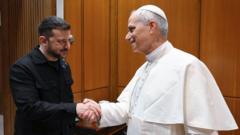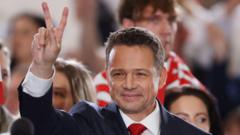The conclave commenced with 133 cardinals taking an oath before casting secret votes in a device profoundly embedded in the church's history. With challenges facing the Catholic Church, the dynamics among the new cardinals may shape the direction of the papacy in the years to come.
Cardinal Assembly Commences in Vatican to Select Next Pope

Cardinal Assembly Commences in Vatican to Select Next Pope
In the historic Sistine Chapel, cardinals gather under Michelangelo's masterpieces to begin the conclave just weeks after the passing of Pope Francis.
Gathered beneath the iconic ceiling of the Sistine Chapel, a remarkable assembly of 133 cardinals has initiated the conclave to select the next pontiff for the Roman Catholic Church. This significant event follows the recent death of Pope Francis and is marked by an atmosphere of solemnity and historical resonance. Upon the closure of the chapel doors, the cardinals began the first phase of their voting process in secret, away from the public eye.
In a historic context, this conclave is noteworthy as it presents the largest ensemble of voting cardinals ever convened. Traditionally cloaked in secrecy, the conclave is designed to ensure extensive obedience to church doctrines and the commitment to maintain privacy surrounding discussions and decisions made within the chamber walls. It occurs at a critical juncture for the Catholic Church as it faces seismic issues including calls for inclusion, response to sex abuse scandals, and financial dilemmas.
The day's events began with a Mass at St. Peter’s Basilica, where cardinals partook in the final public ceremony before their seclusion. Following the Mass, the cardinals swore oaths as part of the rituals, pledging to uphold the conclave rules, including the commitment to secrecy.
The first vote was expected to take place soon after the conclave commenced, although experts suggest that achieving a two-thirds majority necessary for selecting a new pope may not occur immediately. Reports indicate that this conclave might present unique challenges due to the diversity of the cardinals, many of whom are newly appointed and unfamiliar with each other's political leanings and affiliations within the church.
This process of selecting a leader who will guide 1.4 billion Catholics comes alongside discussions on potential successors. Cardinal Pietro Parolin, known as Pope Francis’ second-in-command, has emerged as the frontrunner, alongside several others including Cardinal Luis Antonio Tagle from the Philippines.
The atmosphere inside the Sistine Chapel, adorned with Michelangelo’s renowned works, further accentuates the gravity of the votes cast. As the cardinals deliberate, the world watches closely, knowing the weight of their decision carries implications for the future direction of the Catholic Church and its myriad followers.
Anticipation fills the air as the conclave moves forward, devoid of distractions, with the hopes of both cardinals and Catholics around the globe hinged on the outcome of this pivotal selection. The rituals, shrouded in tradition and secrecy, will play a crucial role in the unfolding drama of the papal election. As the process continues, the interplay between perseverance and divine guidance unfolds amidst the extraordinary setting of one of the world’s most renowned historical sites.




















